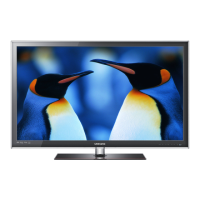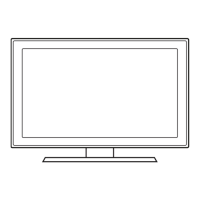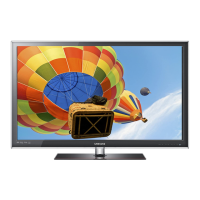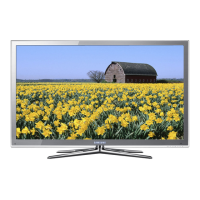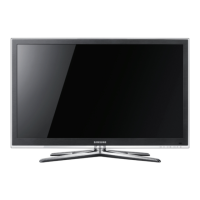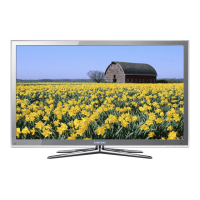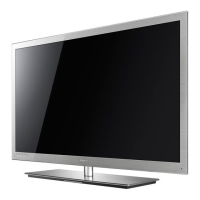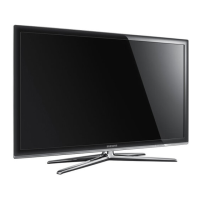Do you have a question about the Samsung UN46C5000 and is the answer not in the manual?
Warning about displaying still images to prevent uneven screen aging and image quality degradation.
Guidance on maintaining safe distances from walls and using proper mounting parts for ventilation and stability.
Highlights key capabilities like digital tuning, media playback, and AllShare connectivity for the TV.
Lists included items like remote control, power cord, and cables, noting potential variations.
Step-by-step instructions for assembling and attaching the TV stand to the television unit.
Identifies and explains the function of the TV's physical control buttons like SOURCE, MENU, VOL, and CH.
Instructions on connecting the power cord and VHF/UHF antenna for initial setup.
Guides users through the automatic on-screen setup process for language, region, and channel scanning.
Explains how to connect external audio/video devices using HDMI/DVI cables, detailing input jacks and potential compatibility issues.
Details connecting devices via Component or Audio/Video cables, recommending Component for better picture quality.
Explains connecting audio systems via Optical (Digital) or Audio (Analog) cables for enhanced sound.
Provides instructions for connecting a PC using HDMI/DVI or D-sub cables for use as a monitor.
Lists supported display modes (resolutions, frequencies) for D-Sub and HDMI/DVI PC connections.
Guides on selecting external input sources via the Source List and renaming inputs for easier identification.
Explains how to use the TV's menu system, including navigation buttons and OSD operation.
Covers managing channels, setting favorites, and memorizing available channels through auto-scan.
Instructions on adding or deleting channels to/from the favorite list for quick access.
Explains how to scan for and store available channels, including selecting the signal source type (Air/Cable).
Details on renaming channels and managing scrambled channels.
How to set timers for channel viewing and manage programmed shows.
Manual adjustment for analog channels to achieve a clear picture, with reset option.
Covers selecting picture modes (Dynamic, Standard, etc.) and adjusting picture settings like brightness.
Explains power-saving features like Energy Saving, Eco Sensor, and Auto Power Off.
Detailed adjustment of picture settings like Black Tone, Dynamic Contrast, Color Space, and White Balance.
How to reset picture settings and configure the TV for use as a PC monitor.
Guidance on adjusting PC resolution, position, and noise filters for optimal display.
Covers selecting sound modes (Standard, Music, Movie) and adjusting audio settings.
Explains Preferred Language, MTS, Auto Volume, and Speaker Select options for audio output.
Details SPDIF output options and how to reset sound settings to factory defaults.
Instructions for setting the clock, using the sleep timer, and configuring the on/off timer functions.
Guides on locking TV programs using V-Chip and setting a PIN for security.
Explains TV Parental Guidelines, MPAA ratings, and Canadian/US rating systems for content blocking.
How to watch restricted channels, change PIN, set menu language, and use captioning.
Customization settings for digital captions, including size, font, color, and opacity.
Explains Game Mode for enhanced gaming and introduces network setup options.
Guides on using the support menu for picture/sound tests and troubleshooting.
Instructions for upgrading TV software via USB or online, and how to get help.
Introduces setting up TV internet access via wired LAN connections.
Details three methods for wired LAN connection using modems or IP sharers.
Steps for automatically configuring network settings via DHCP for internet connectivity.
Instructions for manually entering network settings (IP address, etc.) for static IP networks.
Explains how to connect to a wireless network using a Samsung Wireless LAN Adapter.
Step-by-step guide for connecting wirelessly using the router's WPS button.
Connects devices peer-to-peer without an access point.
Detailed steps for manually configuring network settings if automatic methods fail.
Provides solutions for common internet connection issues like ISP restrictions or firewall problems.
Introduction to playing media files from USB devices or PC via network.
Instructions for connecting USB devices and PCs for media playback.
Lists functions not supported when playing media from PC via network and notes on file systems.
Important considerations before using Media Play, including file system compatibility and backup recommendations.
How to navigate file lists, play videos, and view supported subtitle formats.
Details supported video codecs, containers, and audio codecs for media playback.
Instructions for resuming movie playback and playing music and photos.
How to view photos individually or as a slideshow, with background music options.
How to select and play multiple video, music, or photo files.
Explains how to sort files by category, date, artist, album, genre, or mood.
Details playback options like repeat mode, picture size, sound settings, and subtitles.
Configuration for Continuous Movie Play Help and DivX® VOD registration.
Explains Anynet+ function for controlling Samsung devices and how to connect a home theater.
Details the Anynet+ menu options, setup, and switching between connected devices.
Instructions on how to record TV programs using a Samsung recorder via Anynet+.
How to listen to TV sound through an external receiver or home theater.
Provides solutions for common Anynet+ issues like device not working or not displaying.
Guides on enabling Message, Media, and ScreenShare functions within AllShare.
Details call/schedule alarms, media function, and controlling TV via Samsung phone.
How to use ScreenShare for browsing mobile web content and accessing phone features on the TV.
Illustrates how to neatly manage cables using cable ties for both stand and wall-mount installations.
Steps for assembling the blanking bracket, power cord clamp, and preparing for wall-mount installation.
Provides VESA mounting dimensions, screw specifications, and quantity for TV compatibility.
Instructions on using a Kensington Lock for physical security of the TV, typically in public places.
Detailed instructions and safety precautions for preventing the TV from falling when mounted.
Lists technical specifications including screen size, weight, dimensions, and power for different models.
Provides detailed measurements for front view, side view, and jack panel layout of various TV models.
Resolves problems with no video, power issues, RF/PC/Network connection failures.
Addresses 'Mode Not Supported', caption issues, smell, signal info, settings loss, and display anomalies.
Details software licenses for Dolby, DTS, and DivX technologies used in the TV.
Illustrates connecting AV devices, audio devices, and PCs to the TV.
Covers changing picture modes and setting the TV clock for timer functions.
Explains remote control functions, changing channels/volume, navigating menus, selecting sources, and using Auto Motion Plus.
Guides on connecting to the internet via wired/wireless networks and setting up Media Play for USB devices.
Provides steps for attaching the TV holder and securing it to a wall or cabinet.
Lists FCC, ICES, VCCI, BSMI, KCC, and CE compliance notices for the product.
Details UL safety instructions, compliance with various regional standards (ICES, VCCI, CCC, BSMI, CE), and mercury content.
Details warranty limitations regarding screen aging from prolonged display of stationary images or specific formats.
| Screen Size | 46 inches |
|---|---|
| Resolution | 1920 x 1080 |
| Display Type | LED |
| Refresh Rate | 60 Hz |
| HDMI Ports | 4 |
| USB Ports | 2 |
| Aspect Ratio | 16:9 |
| Viewing Angle | 178 degrees |
| Inputs | HDMI, USB, Component, Composite |
| Sound Output | 20W |
| Energy Efficiency | Energy Star |

